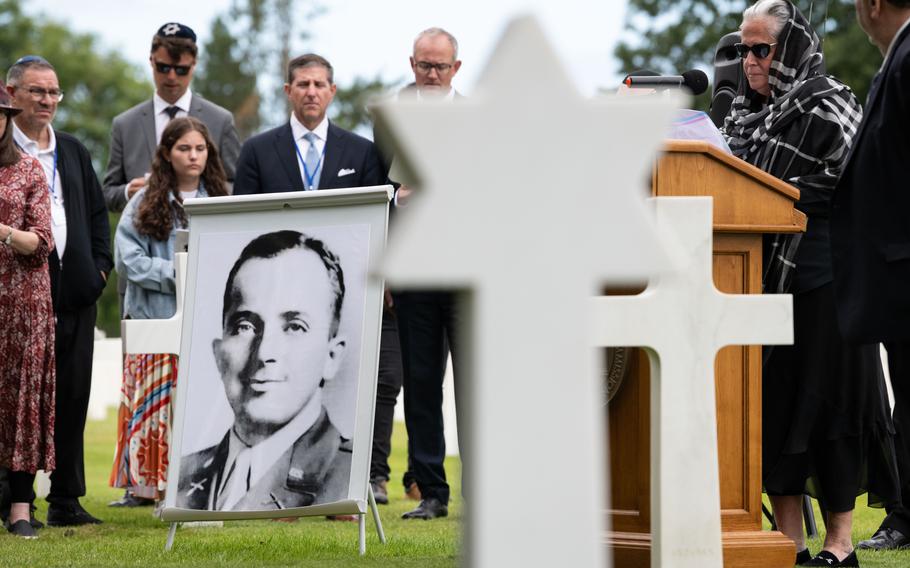
A photo of Army 1st Lt. Nathan Baskind is displayed at his burial ceremony June 23, 2024, at Normandy American Cemetery in Colleville-sur-Mer, France. Baskind fought in World War II and was initially buried in a mass grave with enemy German soldiers. (Phillip Walter Wellman/Stars and Stripes)
COLLEVILLE-SUR-MER, France — A Jewish American soldier who was killed in France during World War II and mistakenly buried in a mass grave for German soldiers has finally joined his fallen comrades in Normandy.
The remains of 1st Lt. Nathan Baskind were interred at the Normandy American Cemetery on Sunday, 80 years to the day when he died in combat at age 28. His coffin was lowered into the earth under a Star of David grave marker, and he received full military honors.
“He was an American hero,” said consul Elizabeth Webster, who represented the U.S. government at the burial. “He will at last rest with his American brothers and sisters in arms who fought alongside him to defeat fascism and restore democracy.”
Baskind, the son of Lithuanian and Russian immigrants who settled in Pittsburgh, was 26 when he was drafted into the Army in 1942.
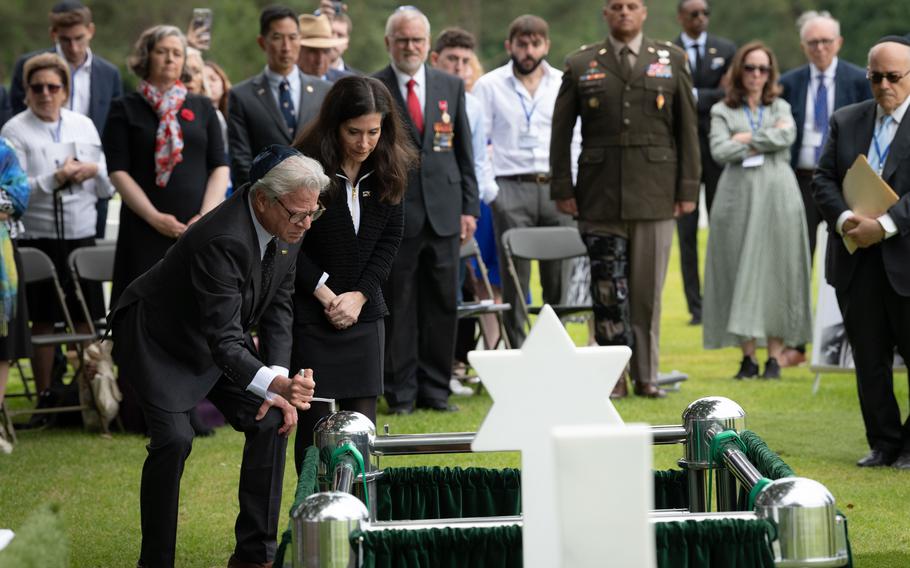
Steward Sadowsky, left, and Samantha Baskind, relatives of 1st Lt. Nathan Baskind, lower the soldier’s casket into the ground at Normandy American Cemetery in Colleville-sur-Mer, France, on June 23, 2024. (Phillip Walter Wellman/Stars and Stripes)
On D-Day, he landed on Utah Beach, about 13 miles from the cemetery’s location, and led four M-10 tank destroyers in the Army’s 899th Tank Destroyer Battalion.
On June 23, 1944, during the Battle of Cherbourg, German soldiers ambushed Baskind and his driver, who were conducting a reconnaissance mission behind enemy lines.
The driver managed to escape and described how Baskind had been hit by machine gun fire, according to the National Archives. He was presumed dead and listed as missing in action on July 13, 1944.
Nearly eight decades later, in 2022, an American genealogist visiting a cemetery in Normandy for German soldiers noticed Baskind’s name on a mass grave, raising his suspicions.
He later contacted Operation Benjamin, a group whose main mission is to identify Jewish soldiers at American military cemeteries who were mistakenly buried under crosses.
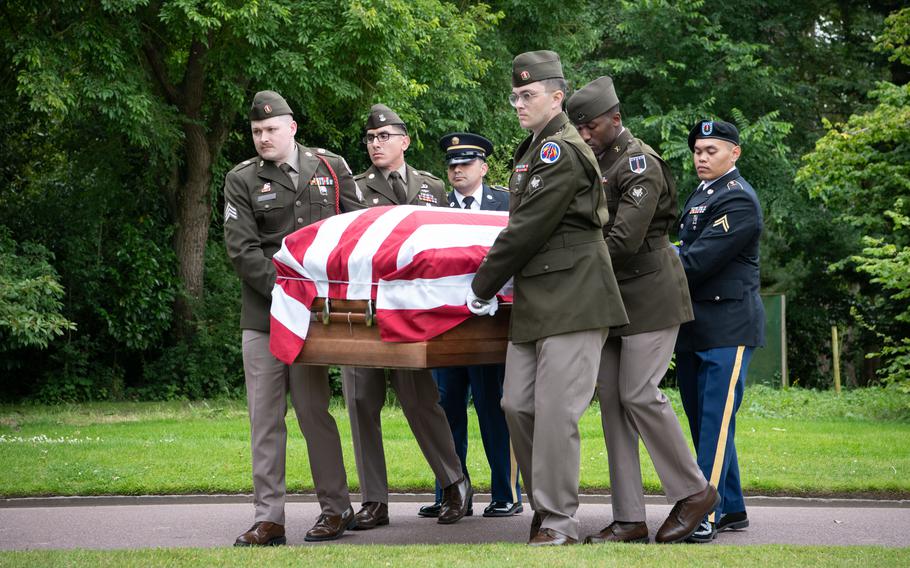
A military honor guard carries the flag-draped casket of Army 1st Lt. Nathan Baskind to his final resting place at Normandy American Cemetery in Colleville-sur-Mer, France, on June 23, 2024. Baskind died during World War II and had been buried with Germans in a mass grave. Germany transferred his remains to the U.S. in May. (Phillip Walter Wellman/Stars and Stripes)
Working with the German War Graves Commission, Operation Benjamin learned through German military records that Nazi forces captured Baskind after he was shot and brought him to a German hospital in Cherbourg, where he died the same night.
German authorities allowed remains to be exhumed from the site in December. There were thousands of bone fragments in the grave, according to Operation Benjamin. Nevertheless, researchers managed to find remains that matched DNA samples provided by Baskind’s surviving relatives.
On Sunday, Brig. Gen. Dirk Backen, secretary general of the German War Graves Commission, said at the ceremony that soldiers like Baskind helped liberate Germany, not just France, from tyranny.
“I wish Nathan B. Baskind could … see that all the bloodshed, the pain, the suffering here at the beaches of Normandy, it was not in vain,” Backen said. “It would not have happened if men like Nathan B. Baskind had not crossed an ocean and went directly into furious battles and gave their days for our tomorrow.”
Rabbi Jacob Schacter, the president of Operation Benjamin, underscored the Germans’ involvement in helping to identify Baskind’s remains.
“The Jewish people were subjected to the worst inhumanity that could possibly be ever perpetrated by one people against another,” Schacter said. “And today we meet in peace, with mutual respect, with admiration.”
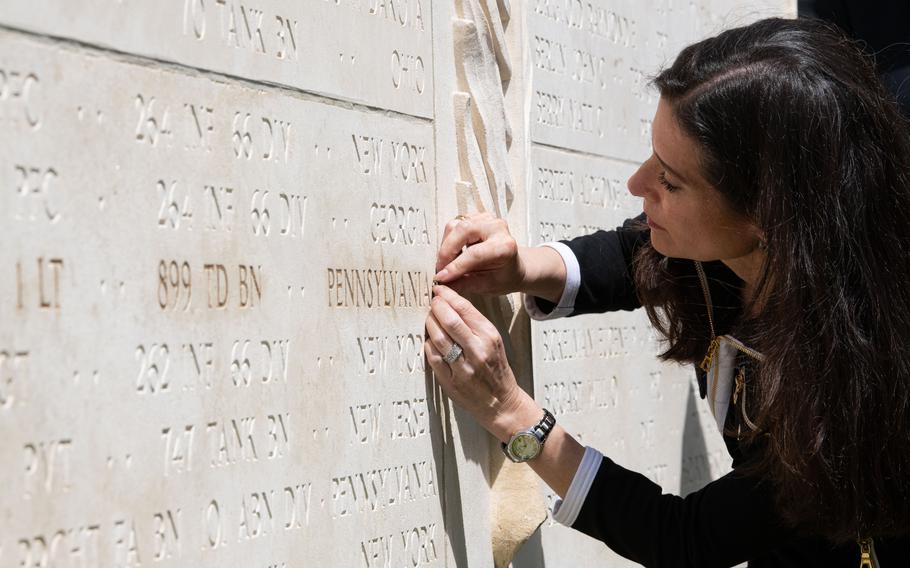
Samantha Baskind inserts a gold rosette into the Wall of the Missing next to the name of 1st Lt. Nathan Baskind at Normandy American Cemetery on June 23, 2024, signifying that her great-uncle’s remains have been found. (Phillip Walter Wellman/Stars and Stripes)
The German army handed over Baskind’s remains to the U.S. at a ceremony at Ramstein Air Base in May.
Days before, Baskind’s great-niece Samantha Baskind, an art history professor at Cleveland State University, received his Purple Heart from the Defense POW/MIA Accounting Agency. She hadn’t known much about her uncle growing up but was involved with the recovery efforts.
Speaking at the burial ceremony, she shared the little information she knew about him, including that his middle initial stood for “Brother,” as stated on his birth certificate.
His twin sister’s legal middle name was “Sister,” she said, suggesting that perhaps their immigrant parents were confused by the birth certificate forms they had to complete.
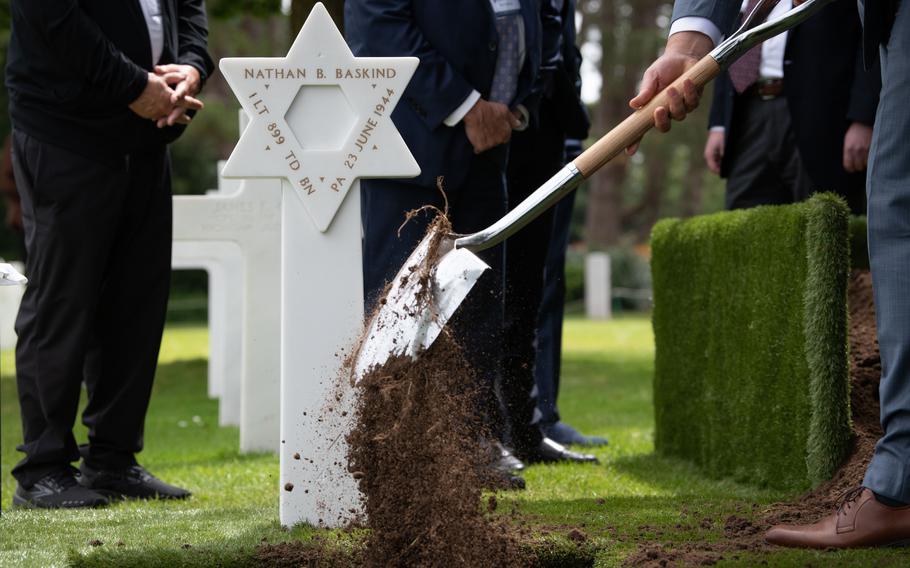
Dirt is shoveled into the grave of Army 1st Lt. Nathan Baskind, who was buried at Normandy American Cemetery in France on June 23, 2024, exactly 80 years after his death in World War II. (Phillip Walter Wellman/Stars and Stripes)
Nathan Baskind’s mother and father died years ago without ever knowing what happened to their son. Samantha Baskind and family member Steward Sadowsky lowered Baskind’s coffin into the ground Sunday.
The new grave adds to those of roughly 9,400 men and four women buried at Normandy American Cemetery. Baskind’s name is among over 1,557 included on the cemetery’s Wall of the Missing.
After his burial, his great-niece inserted a rosette into the wall next to his name, signifying he’s been found.
“Nate’s journey, and our journey, is complete,” she said.